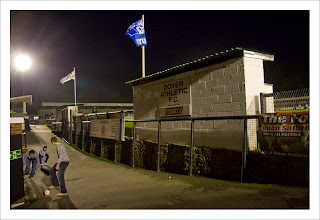27 March 2010
Marlow 3 Bedworth United 3
Zamaretto Southern League, Division One Central
Attendance: 103
View all photographs (68)
Marlow Football Club is one of the oldest in existence: founded in 1870 as Great Marlow. One of the original 15 entrants to the FA Cup the following year, the club remains the only one to have entered the competition in every year since its inception.
In 1881-82 Marlow reached the semi-finals of the FA Cup, only to be beaten by Old Etonians, at Kennington Oval. More recently, in 1992-93 they reached the 3rd Round proper and were rewarded with a home tie against Tottenham Hotspur. The game was switched to White Hart Lane, with Spurs winning 5-1. The same round was reached again two seasons later, with Marlow this time going down at Swindon Town.
After the Great War the club was forced to move from its ground at Crown Meadow, to rather basic surroundings at Star Meadow. This was unsatisfactory and Marlow were demoted as a consequence - an early example of ground grading!
Demotion prompted the club’s Honorary Secretary Alfred Davis to appeal for funding which enabled the club to purchase the ground in Oak Tree Road. Davis contributed much of the funding himself but sadly did not live to see the ground opened in 1924. Quite properly the ground was named in his memory, and one of the walls on the front of the stand carries a very attractive ornate wrought iron memorial. Trees were also planted to commemorate the work of Davis in 1936. The splendid wooden stand dates from 1930.
The ground had remained largely unchanged since my previous visit in 2004, although a pile of 'reclaimed' crush barriers, optimistically acquired from neighbours Wycombe Wanderers, was evidence behind the far goal.
Currently competing in the Central Division of the Zamaretto-sponsored Southern League, the visitors on this occasion were Bedworth United. As can be seen from the photographs it was grey and overcast for most of the afternoon, and a significant portion of the first half was spent in frustration, sheltering from heavy cloudbursts. Marlow led three times in the match but also conceded three goals themselves.
In 1881-82 Marlow reached the semi-finals of the FA Cup, only to be beaten by Old Etonians, at Kennington Oval. More recently, in 1992-93 they reached the 3rd Round proper and were rewarded with a home tie against Tottenham Hotspur. The game was switched to White Hart Lane, with Spurs winning 5-1. The same round was reached again two seasons later, with Marlow this time going down at Swindon Town.
After the Great War the club was forced to move from its ground at Crown Meadow, to rather basic surroundings at Star Meadow. This was unsatisfactory and Marlow were demoted as a consequence - an early example of ground grading!
Demotion prompted the club’s Honorary Secretary Alfred Davis to appeal for funding which enabled the club to purchase the ground in Oak Tree Road. Davis contributed much of the funding himself but sadly did not live to see the ground opened in 1924. Quite properly the ground was named in his memory, and one of the walls on the front of the stand carries a very attractive ornate wrought iron memorial. Trees were also planted to commemorate the work of Davis in 1936. The splendid wooden stand dates from 1930.
The ground had remained largely unchanged since my previous visit in 2004, although a pile of 'reclaimed' crush barriers, optimistically acquired from neighbours Wycombe Wanderers, was evidence behind the far goal.
Currently competing in the Central Division of the Zamaretto-sponsored Southern League, the visitors on this occasion were Bedworth United. As can be seen from the photographs it was grey and overcast for most of the afternoon, and a significant portion of the first half was spent in frustration, sheltering from heavy cloudbursts. Marlow led three times in the match but also conceded three goals themselves.

















